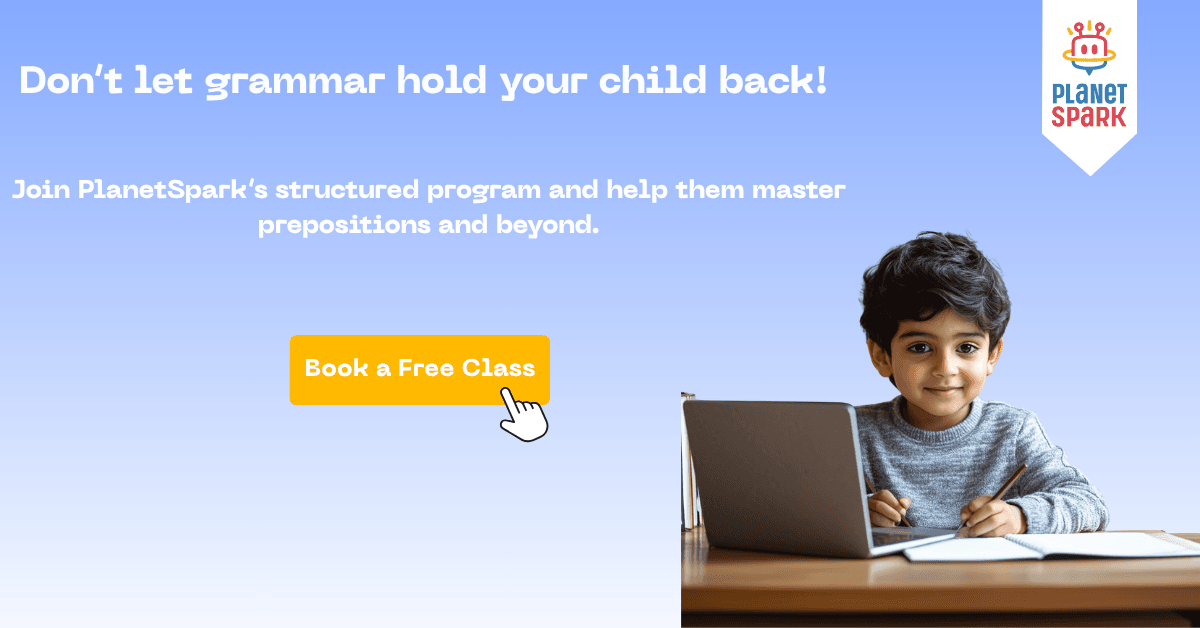English Grammar Prepositions for Class 4

Prepositions are one of the most important building blocks of English grammar. These tiny words may seem simple, but they carry a lot of meaning and play a key role in linking different parts of a sentence. Prepositions describe relationships between nouns or pronouns and other elements in a sentence, indicating things like time, place, direction, movement, cause, and more.
Understanding how to use prepositions correctly is essential for Class 4 students to write clear, meaningful, and grammatically accurate sentences. In this detailed blog, we’ll explore the definition of prepositions, rules for usage, types of prepositions, and examples to make learning fun and easy for young learners.
What Is a Preposition?
A preposition is a word or group of words that connects a noun or pronoun to another word in the sentence, showing the relationship between them. It often answers questions like where?, when?, how?, or in what direction?
Example:
The book is on the table.
In this sentence, "on" is the preposition that shows the relationship between "book" and "table."

Prepositions help to make sentences more informative and are essential for expressing ideas clearly. Without them, communication would be vague or incomplete.
Rules for Using Prepositions
Here are some important rules every Class 4 student should know before using prepositions:
1. A Preposition Must Always Have an Object
A preposition always comes with an object. The object is usually a noun, pronoun, or noun phrase that completes the meaning of the sentence.
Example: She put the cookies in the jar. ("In" is the preposition, and "jar" is the object.)
2. Prepositions Precede the Object
In English, the preposition comes before its object. Placing it incorrectly can make the sentence confusing or incorrect.
Example: They walked to the park.

3. Use the Correct Pronoun After a Preposition
After a preposition, always use object pronouns like me, him, her, us, and them, not subject pronouns like I, he, she, we, or they.
Example: He gave the pencil to her. (Not: to she)
4. Prepositions Can Be One Word or Phrases
Some prepositions are simple (e.g., in, on, by), while others are compound or phrasal (e.g., according to, in front of, instead of).
Example: He acted according to the rules.
5. Preposition "to" vs Infinitive "to"
There’s often confusion between “to” as a preposition and “to” used in an infinitive (to + verb).
Example (preposition): She is looking forward to the holidays.
Example (infinitive): She wants to go to the beach.
6. Prepositions Are Followed by Nouns or Pronouns, Not Verbs
After a preposition, we use a noun, noun phrase, or pronoun, but not a verb in its base form.
Correct: He is fond of dancing.
Incorrect: He is fond of dance.

Types of Prepositions
Prepositions can be grouped into different types based on their function. Let’s explore the major categories that Class 4 students need to know.
1. Prepositions of Time
These prepositions indicate when something happens. Common examples include: in, on, at, since, for, ago, before, after, by, during
Examples:
I was born in the year 2012.
The event starts at 10 a.m. sharp.
My friends came to visit me on Saturday.
I haven’t seen her since last week.
The exams lasted for two hours.
2. Prepositions of Place
These show the location of someone or something in relation to other things.
Common prepositions of place include: in, on, at, under, above, below, next to, behind, in front of, between
Examples:
The dog is sleeping under the table.
She kept the gifts on the shelf.
My house is next to a grocery store.
He stood in front of the gate.
The painting hangs above the sofa.
3. Prepositions of Direction or Movement
These prepositions show movement from one place to another or the direction in which something moves.
Examples include: to, into, onto, across, through, towards, from, down, along, away
Examples:
We walked towards the exit.
She jumped into the pool.
He ran across the street to catch the bus.
The ball rolled down the hill.
Birds flew away from the loud sound.
4. Prepositions of Location
These are used to describe the exact position or address of someone or something. They are often used in formal settings like describing buildings, events, or city locations.
Common words include: at, on, in, inside, near, beside, opposite, in between, below, above
Examples:
She works at the city hospital.
They live on Rosewood Street.
The restaurant is in between the bank and the pharmacy.
The shoes are kept inside the cupboard.
The fan is above the bed.
Practice Exercise – Fill in the Blanks
Try filling in the blanks using the correct prepositions:
The cat is sitting ___ the table.
She arrived ___ the airport on time.
He went ___ the house and sat on the couch.
The school is located ___ MG Road.
We travelled ___ the jungle during our trip.
Answers: under, at, into, on, through
Why Learn Prepositions in Class 4?
At the Class 4 level, students are developing a deeper understanding of how to form complex sentences and express ideas clearly. Prepositions are critical in helping them:
Build grammatically correct sentences
Describe time and space accurately
Connect ideas more logically
Perform better in written and spoken English assessments
Prepare for grammar exams and competitions like Spell Bee or Olympiads
Learn English Grammar the Smart Way with PlanetSpark
At PlanetSpark, we offer a structured English Grammar course tailored for Class 4 learners. It includes:
1:1 Live Classes with Expert Tutors
Gamified Quizzes and Exercises
Personalized Feedback & Learning Plan
Regular PTMs and Progress Reports
Fun Worksheets and Real-World Examples
Give your child the gift of fluent grammar. Let them learn with PlanetSpark.
Visit PlanetSpark’s Grammar Program for Class 4 to get started.
Read more about english grammar topics
Personalized Communication Report
Record a video to get a AI generated personalized communication report for your child

Hi There, want to try these
tips for your child with
LIVE with our expert coach?
Let's check your child's
English fluency
